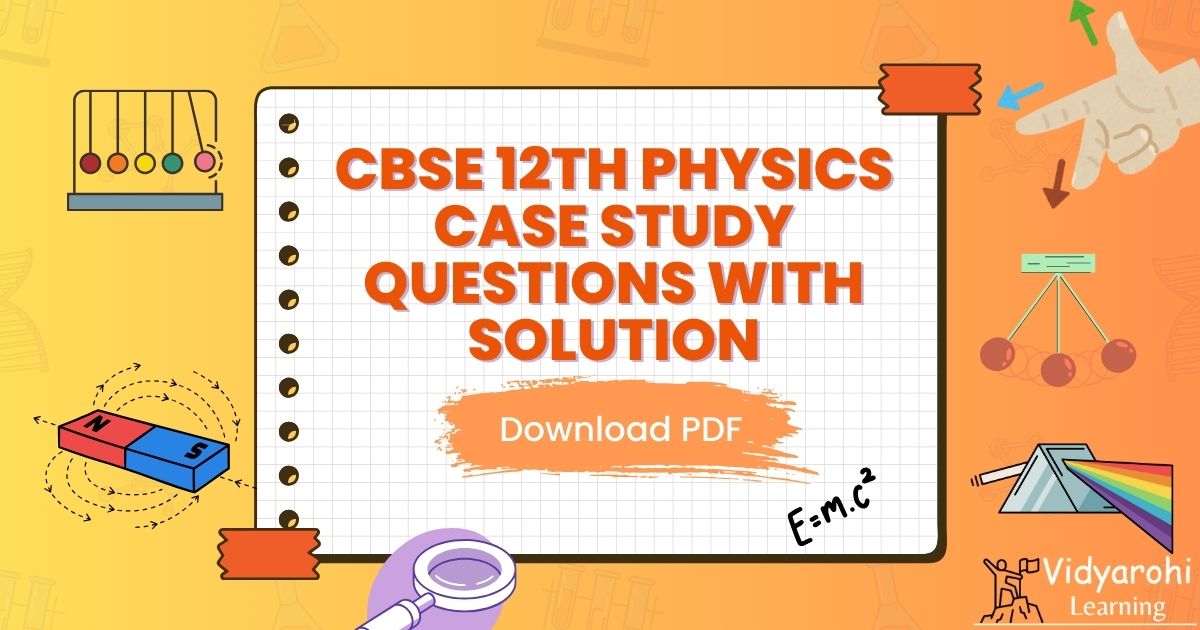CBSE 12th Physics Case Study Questions: Class 12 is one of the most important stages in a student’s school life. The Central Board of Secondary Education (CBSE) has been updating its exam pattern to focus more on real understanding rather than rote learning. One major change is the addition of Case Study Questions in almost every subject. In Physics, these questions test how well students can use concepts in real-life situations instead of just memorising concepts and formulas. For the 2025 CBSE Class 12 Physics exam, Case Study Questions will continue to be an important part of the paper because they check analytical thinking and problem-solving skills. This article explains what Class 12 Physics Case Study Questions are, their format, examples, and how to prepare for them. It will help you understand concepts better, study smartly, and feel more confident during the exams.
Also check,
What are CBSE Class 12 Physics Case Study Questions?
CBSE Class 12 Physics Case Study Questions aren’t just about theory or concepts. They aim to bridge the gap between classroom learning and real-life applications. As CBSE continues to focus on competency-based assessments, these types of questions are expected to become even more important in future exams.
Case Study Questions are a type of competency-based question designed to test a student’s ability to:
- Apply Physics concepts in real-life situations
- Analyse the given information or data
- Solve problems based on application and reasoning
Instead of direct numerical problems, these questions come with a short passage, situation, or case, followed by 2-4 objective or subjective questions related to that case.
Also check,
CBSE Class 12 Physics Case Study Question Format
According to the CBSE Class 12 Physics Paper Design 2025, the paper includes:
- 2 Case study-based questions, carrying 4 marks each.
- In Section D of the question paper
- One case study question has four MCQs of mark 1 each with no internal choice.
- The other case study question will have three descriptive questions of 2, 1 and 1 mark each with no internal choice.
These questions require students to understand the given case, extract relevant information, and solve accordingly.
Chapters for Class 12 Physics Case Study Questions
CBSE tends to pick case-based questions from chapters that lend themselves to real-world applications. Chapters from Which Class 12 Case Study Questions that are commonly asked are listed below:
- Electrostatics: Electric charges, electric field, and potential
- Current Electricity: Ohm’s law, circuits, and internal resistance
- Magnetic Effects of Current & Magnetism: Moving charges, magnetic fields, and earth’s magnetism
- Electromagnetic Induction & Alternating Current: EMF, transformers, and AC circuits
- Optics: Ray optics, wave optics, refraction, diffraction, and polarisation
- Dual Nature of Matter and Radiation: Photoelectric effect
- Semiconductor Electronics: Diodes, transistors, logic gates, and communication systems
Also check,
Importance of Case Study Questions in Class 12 Physics
Case study questions in Class 12 Physics are an important part of the CBSE Board Exam. They are designed to test not just theoretical knowledge but also the ability to apply concepts to real-life situations. These questions push students to think critically, analyse data, and develop problem-solving skills rather than simply memorising formulas. By practising case study questions, students gain a deeper understanding of Physics concepts and improve their exam performance. They also help reduce exam fear because students learn how to approach different types of problems with confidence.
- Encourages students to apply theoretical concepts to practical and real-life scenarios.
- Improves the ability to analyse data, graphs, and case-based situations logically.
- Enhances skills needed to solve multi-concept and integrated questions.
- Help students understand the utility of Physics in daily life
- Helps students understand concepts deeply instead of rote learning.
Tips to Solve Physics Case Study Questions Effectively
To solve Physics case study questions effectively, first read the question carefully and understand the real-life situation given. Identify the Physics concepts or formulas needed to solve it. Break the problem into small parts and solve step by step. Practice similar questions regularly to improve speed and accuracy. Here are some expert tips for solving Class 12th Physics Case Study Questions effectively:
1. Read the Case Carefully: Take time to understand the situation, data, and what exactly is being asked before attempting.
2. Identify the Chapter and Concept: Match the scenario with the Physics chapter or topic it belongs to (e.g., electricity, optics, or motion).
3. Break Down the Problem: Treat each sub-question individually. Don’t get overwhelmed by the case’s length; they are often easier than they look!
4. Draw Diagrams or Sketches: Sketching a simple diagram can make the problem clearer and help you visualise the concept.
5. Use Formulas Appropriately: Pick the correct formula and substitute values carefully to avoid calculation mistakes.
6. Check Units and Conversions: Make sure all measurements are in the same unit system before solving.
7. Write Clear, Short Answers: Keep your explanation simple and to the point to save time.
8. Practice from Sample Papers and Past Year Papers: Use the CBSE Sample Paper 2025 and previous years’ board papers to practice similar case-based questions.
CBSE Class 12 Physics Case Study Question
Let’s look at an example to understand how these questions appear:
Case No.1: The phenomenon of making a region free from any electric field is called electrostatic shielding. It has a variety of applications. One such is that during a lightning thunderstorm, it is advised to stay inside the car and not under trees or in the open ground because the outer metallic body of the car acts as an electromagnetic shield from the lightning.
Based on the above information, answer the following question:
(i) The total charge inside a conductor is
(a) Non-zero
(b) Zero
(c) Depends on the electric field
(d) Depends on the electric field present inside the conductor.
Answer: (b) Zero
(ii) Electric field lines
(a) are always perpendicular to the surface of a conductor
(b) are always along the tangential direction to the conductor
(c) are always zero inside the conductor
(d) None of the above
Answer: (a) are always perpendicular to the surface of a conductor
(iii) The first step involved in using Gauss’s law is
(a) Choose a closed Gaussian surface
(b) Calculate the electric field
(c) Estimate the size of the surface
(d) None of the above
Answer: (a) Choose a closed Gaussian surface
(iv) The amount of flux moving radially outward depends on
(a) Surface area of the Gaussian surface
(b) Charge present inside the Gaussian surface
(c) Both the above
(d) None of the above
Answer: (b) Charge present inside the Gaussian surface
Case No.2: A village with a demand of 600 kW of electric power at 200 V is situated 20 km away from an electric plant generating power at 440 V. The resistance of the two-wire line carrying power is 0.4 Ω per km. The village gets power from the line through a 3000 - 200 V step-down transformer at a substation in the town.
Based on the above information, answer the following question:
(i) What is the total resistance of the wires?
(a) 8 Ω
(b) 16 Ω
(c) 32 Ω
(d) 64 Ω
Answer: (b) 16 Ω
(ii) What is the power loss in the form of heat during the transmission?
(a) 160 kW
(b) 320 kW
(c) 640 kW
(d) 1280 kW
Answer: (c) 640 kW
(iii) What is the voltage drop in the power line?
(a) 3200 V
(b) 1600 V
(c) 800 V
(d) 400 V
Answer: (a) 3200 V
(iv) How much power must the plant supply, assuming there is negligible
power loss due to leakage?
(a) 600 kW
(b) 640 kW
(c) 1000 kW
(d) 1240 kW
Answer: (d) 1240 kW
(v) What is the transmission voltage at the plant?
(a) 6200 V
(b) 7000 V
(c) 7200 V
(d) 8000 V
Answer: (a) 6200 V
Q.No.3: According to Bohr’s famous frequency condition, an atom can emit or absorb radiation in the form of discrete energy photons only when an electron jumps from higher to a lower orbit or from a lower to a higher orbit, respectively.
If E1 and E2 are the energies associated with these permitted orbits, then the frequency v of the emitted or absorbed radiation is given by,
hv = E2 – E1.
(i) Calculate the frequency of the photon, which can excite the electron to –3.4 eV from –13.6 eV
(ii) The ground state energy of a hydrogen atom is –13.6 eV. What is the kinetic energy of an electron in the 2nd excited state?
(iii) If the electron in question (ii) jumps to the ground state from the 2nd excited state, calculate the wavelength of the photon emitted.
Answer: (i) 2.47 × 10^15 Hz, (ii) 1.51eV, (iii) 1023Å
CBSE Class 12 Physics Case Study Question PDF [Free]
Click on the link provided below to download the CBSE Class 12 Physics Case Study Question PDF with answers for free without any login. Get the direct link to download the PDF.
| CBSE Class 12 Physics Case Study Question PDF | Download here |
| CBSE Class 12 Physics Case Study Question- Solution PDF | Download here |
Common Mistakes to Avoid In Physics Case Study Questions
- Skipping the passage: Students often directly jump to the question without understanding the context.
- Misinterpreting the case: Especially in word problems involving diagrams or figures.
- Not revising key formulas: Weak formula recall can ruin your answer.
- Lack of practice: These questions are relatively new, and many students aren’t used to them yet.
CBSE Class 12 Physics Syllabus 2025-26
The Central Board of Secondary Education (CBSE) has released the Physics Syllabus for Class 12 Science streams for the 2025-26 academic year. This Physics Syllabus outlines the course structure, chapters, and topics that students will need to study in the subject. The CBSE Class 12 Physics syllabus covers a wide range of topics, including Electrostatics, Current Electricity, Magnetic Effects of Current and Magnetism, Electromagnetic Induction and Alternating Currents, Electromagnetic waves, and Optics. It is divided into units with specific weightage, helping students plan their preparation effectively. The unit-wise chapters and weightage are provided below :
| Unit No. | Unit Name | Marks |
| I | Electrostatics |
16 |
| II | Current Electricity | |
| III | Magnetic Effects of Current and Magnetism |
17 |
| IV | Electromagnetic Induction and Alternating Currents | |
| V | Electromagnetic waves |
18 |
| VI | Optics | |
| VII | Dual Nature of Radiation and Matter |
12 |
| VIII | Atoms and Nuclei | |
| XI | Electronic Devices | 7 |
| Total | 70 | |
| Practical | 30 |
Check the latest and detailed CBSE Class 12 Physics Syllabus 2025-26; Check Latest Unit-wise Weightage, Download PDF.
CBSE Class 12 Physics Exam Pattern 2025
CBSE has released the exam pattern and marking scheme for the 2025-26 academic year. The board followed the same exam pattern and marking scheme as in 2024-25. The CBSE Class 12 Physics board exam consisted of a theory paper of 70 marks and a Practical of 30 marks. The question paper was divided into five different sections:
| Section | Question Type | Number of Questions | Marks |
| A | Multiple Choice Questions & Assertion and Reason Questions (1 mark) | 16 | 16 |
| B | Very Short Answer (2 mark) | 5 | 10 |
| C | Short Answer (3 marks) | 7 | 21 |
| D | Case Study-Based Questions (4 marks) | 2 | 8 |
| E | Long Answer (5 marks) | 3 | 15 |
| Total | 33 | 70 | |
Check the latest and detailed CBSE Class 12th Physics Exam Pattern 2025-26 with Marking Scheme.


